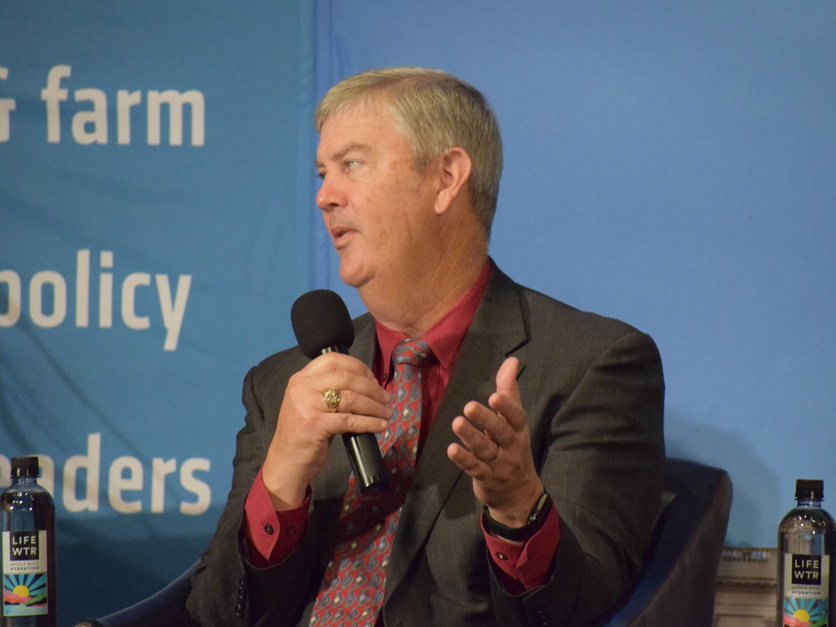Federal Reserve action to curb inflation is also having an impact on the business decisions of American producers, according to a panel of ag economy experts speaking Monday at the Agri-Pulse Ag and Food Policy Summit.
Interest rates have ticked higher over the last year, and media reports indicate another quarter-point hike could take place this week. After years of robust commodity prices and a solid farm economy, many producers have cash on hand, and they’re using it to avoid relying on changes in the market for credit.
“The one place that the high interest rates are really bothering (farmers) is their operating notes,” Joe Outlaw, a professor and extension economist with Texas A&M, said during a panel discussion. “The cost of (planting) crops is so much more across the board; not just fertilizer went up, but everything went up.”
“Their operating note interest is going to be substantial, which is going to eat into profits,” he added.
Outlaw pointed to “anecdotal” evidence of many farmers opting to hold off on major expenditures like equipment purchases “to see where interest rates are going to go.”
 Joe Outlaw, Texas A&M
Senate Ag GOP staff economist John Newton noted a precarious position for many in the farm economy, including producers of row crops who can expect sizable drops in commodity prices, but not quite to the level that will be covered by farm bill risk management programs. He said safety net levels falling short of commodity price drops is going to be “something that I think we want to address, and it’s a big priority of ours in the farm bill.”
Joe Outlaw, Texas A&M
Senate Ag GOP staff economist John Newton noted a precarious position for many in the farm economy, including producers of row crops who can expect sizable drops in commodity prices, but not quite to the level that will be covered by farm bill risk management programs. He said safety net levels falling short of commodity price drops is going to be “something that I think we want to address, and it’s a big priority of ours in the farm bill.”
While producers have demonstrated concern about the state of their own operations, an influx of private capital is offering chances to fund new, innovative practices across many different production systems. Audre Kapacinskas with S2G Ventures, a $2 billion fund investing in many food and agriculture startups, said investment in agricultural technology has grown 10-fold in the last decade.
Many innovations now in front of venture capitalists, she said, were not ready for private-sector investment at the time the last farm bill was developed, and S2G is seeing an influx of investor attention to agriculture and its climate-related possibilities.
“We think that the farm bill and policy have a huge role to play in de-risking this space,” she said. “Private investors are very interested in the space, we're going to continue acting in it.”
It’s not just investors in Silicon Valley; many have opted to join agriculture in a more hands-on fashion. Gary Matteson, who works with beginning farmer programs at the Farm Credit Council, said the Farm Credit system made $63 billion in loans to beginning farmers from 2019-2021, and many of those new growers are not producing familiar commodities like corn and soybeans. Instead, they are “mission-based” and trying to meet the needs of the communities near their farms.
Don’t miss a beat! It’s easy to sign up for a FREE month of Agri-Pulse news! For the latest on what’s happening in Washington, D.C. and around the country in agriculture, just click here.
“They're doing a very different kind of agriculture that is much more entrepreneurial, much more retail focused,” he said. “Whether it's growing food for people, or raising their family on a farm, it's about a sense of mission. That's what's driving beginning farmers, especially most who are entering agriculture.”
Outlaw, who maintains a list of “representative farms” as part of his work studying the farm economy, said that lined up with his experience in working with younger producers. About one-third of the growers he corresponds with might be taking over the family operation and bring with them different views on the incorporation of technology in their operation. But they also lack the experience of previous generations in dealing with risk, which is shaping their views of the current farm economy.
It’s a paradigm he said might require some education and perspective from farmers and lenders who have dealt with similar issues before.
“(Young producers) have grown up in a time where there was relatively decent profitability,” he said. “They weren't alive whenever the interest rates were doing what they're doing now. And so you have to kind of help them through that process.”
For more news, go to www.Agri-Pulse.com.


